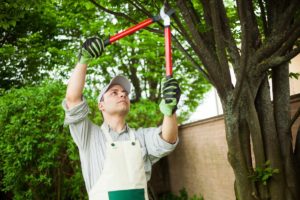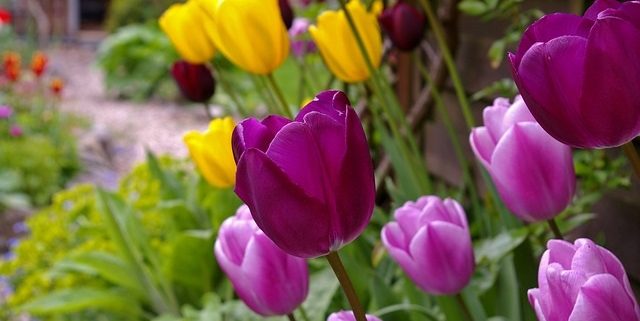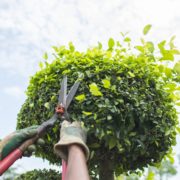Five Spring Landscaping Tips For Indianapolis Homeowners
There’s nothing that gives the Hoosier heart quite the boost as seeing the gentle rise of bulbs popping forth from the cold ground, buds bursting forth on trees and the gentle weeping willow branches turning magnificent chartreuse as temperatures warm.
But as most homeowners know, this is no time to dilly dally or wax poetic about “a young man’s fancy …” This is the time to hit the ground running and get a jump on weeds, unwieldy trees and mulch while ridding your yard of those things you found particularly annoying last season. It can be an overwhelming task – so much to do, so little time, right? We get it! A landscape professional is standing by to assist with the following tasks!
1) Spring Yard Clean Up
Most homeowners have good intentions about getting their yard in ship-shape condition in the fall. In mid-October they look around – the weather is still warm, flowers and shrubs are still blooming and you’re lulled into a false sense of security about the weather. Two weeks later, the temperatures have dropped into the 40s for highs and the first frost is history; plants have turned brown and your poor yard looks sad. And as much as you’d like to get out there and make it pretty, it’s cold. You may clear away just enough yard debris to allow for the staging of your holiday décor, but there’s still a lot of work to do. And now it’s spring. So, what needs to be done?
Shrub and bush pruning always leads the pack and can be done in early spring. Most shrubs – including roses and ornamental grasses – welcome getting pruned  back to make way for this season’s growth. This is a pretty healthy cut (all the way to the ground to maybe 10-inches or so) that may make you nervous, but it’s the very best thing for these plants. Be warned, some of your spring flowering shrubs and bushes – like lilacs, hydrangeas forsythia and rhododendron – bloom on “old wood.” Trimming them back takes away all of their beautiful blossoms. A landscape professional will easily identify these plants, but it never hurts to do a “walk around” with your contractor just to make sure.
back to make way for this season’s growth. This is a pretty healthy cut (all the way to the ground to maybe 10-inches or so) that may make you nervous, but it’s the very best thing for these plants. Be warned, some of your spring flowering shrubs and bushes – like lilacs, hydrangeas forsythia and rhododendron – bloom on “old wood.” Trimming them back takes away all of their beautiful blossoms. A landscape professional will easily identify these plants, but it never hurts to do a “walk around” with your contractor just to make sure.
Tree trimming is another spring task that is more preventative than anything else. Take a good look at your trees to identify any low-hanging or dead branches, particularly if those pose a hazard to your home, electrical lines or anyone walking under them! Hoosier springs are legendary for their tornado activity, and the last thing you want is a dead limb that acts as a projectile. Tree trimming is at the top of our list of “things best left to a professional.” Sure, you can do it on your own, and there are some pretty awesome ratcheted, telescopic trimmers that allow you to take out a three-inch-diameter branch with ease. But, much like stretch pants, just because you CAN, does not necessarily mean it’s advisable to attempt.
Removal of dead leaves, grass around existing plants gives spring’s burgeoning growth a little breathing room. Carefully and gently rake them up as to not to disturb tender new leaves and stems – and think about starting a compost pile for next fall.
2. Get Ready for Green Grass
Weed and feed: two words for a healthy summer yard
Weed. Putting down a pre-emergent weed killer in early spring (see the guideline below) goes a long way in stopping the cursed sprouting of dandelions, crabgrass, chickweed and other grim reapers of green. One thing to consider: You cannot use this if you are planning on reseeding or over-seeding your yard, as pre-emergent products are not discerning. While they won’t allow weed seeds to grow, they won’t let grass (or flower) seeds grow as well. If you’re planning on sowing some native flower seeds in the spring, make sure that area is free from any sort of weedkillers, etc.
 When do you put down that pre-emergent? An old rule of thumb is to distribute shortly after the flowering period of the forsythia bushes (the yellow flowering bushes abundant throughout Central Indiana, but perhaps most beautifully along Westfield Boulevard going south into Broad Ripple) but shortly before the lilac bushes bloom (the beautiful purple flowers that smell heavenly and a probably remind you of your grandmother).
When do you put down that pre-emergent? An old rule of thumb is to distribute shortly after the flowering period of the forsythia bushes (the yellow flowering bushes abundant throughout Central Indiana, but perhaps most beautifully along Westfield Boulevard going south into Broad Ripple) but shortly before the lilac bushes bloom (the beautiful purple flowers that smell heavenly and a probably remind you of your grandmother).
If you want to get all scientific with it (it’s a fun thing to do with your kids), you can use a soil thermometer to take a reading of the soil temperature a couple of inches down into the ground where your grass is growing. The best time to apply crabgrass and broadleaf weed preventer will be when the soil temperature reaches 55-60 degrees Fahrenheit and holds that reading for a few days in a row. (A helpful tip is to use a screwdriver to make a “pilot” hole, so you don’t break your thermometer!)
But what if the right time for using pre-emergent passes, and you end up with the weed in your lawn during the summer? One option is to use a post-emergent crabgrass/broadleaf killer.
Feed. Certain fertilizers are best for your yard, depending on the time of the season – for spring, the experts recommend a slow-release or controlled-release fertilizer to reduce possible losses to the environment and increase nutrient absorption.
It’s important to read the label on the fertilizer bag and to know the exact size of your lawn. Using too much fertilizer can harm your lawn and cost you more than you planned. Conversely, using too little fertilizer won’t yield the results anticipated. Several university studies show that under-fertilized turf can lead to soil erosion and unwanted soil runoff. Always follow the label instructions!
While you’re at it, fertilize trees and shrubs, too. Most plants, trees, and shrubs will benefit from proper fertilization with a slow-release product just before mulch is applied.
Option: Aeration
Aeration can be a right of spring or fall when the weather is cool. Aeration perforates the soil with small holes to allow air, water and nutrients to penetrate the grassroots. This helps the roots grow deeper and produce a stronger, more vigorous lawn. It alleviates soil compaction that occurs with new homes (where the topsoil is often stripped), where excessive thatch occurs, or in sodded lawns. Your landscape professional can provide insight if this alone, or combined with overseeding grass – would be beneficial for your lawn.
3. Mulch
You know it’s spring when you see the huge piles of mulch arrive on your neighbor’s driveway. And you just hope they get it spread sometime before July, right? Show them how to do it – get out there early with your rake and shovel in your own yard … or, better yet, hire a landscape professional!
Prior to mulching, make planting beds neat and tidy. Rake the old leaves and debris from plant beds and create neat, natural edges around the beds using an edging tool.
Add an inch-thick layer of fresh mulch in plant beds and around trees. Don’t let the mulch touch tree trunks and never let the mulch accumulate to more than a 3-inch depth. In addition to the aesthetic curb appeal of mulch, it also helps to retain moisture in the soil throughout the season (like those dry days of July and August!), keeps roots cool in the summer, and insulates them in the winter. As mulch decomposes, it adds organic matter to the soil.
4. Prepare to Plant
Soil preparations are something homeowners sometimes overlook or discount as unnecessary. If you live in Central Indiana, you need to amend your soil before plopping a new plant in the dirt. The likelihood that you have a high concentration of clay in your yard is pretty great – and putting a new plant in there is like planting in a bucket of plaster. So, how to amend the soil? A 2 -2-1 mix of organic compost-manure-builders sand or peat will do the trick. If you’re planting new perennials, shrubs or bushes, dig the hole twice as big as needed and fill in with the amended material. If you’re creating a new flower bed, plan on at least four inches of new material dug into the old soil for best results. (Click for additional information).
And one more important preparation: It’s really important to empty out your flower pots and clean with a mixture of a couple of tablespoons of bleach to a gallon of water. This will rid them of any lingering diseases or insects that may have plagued your plants last year. It provides a “fresh start” for this growing season!
5. Plant away!
Timing is everything. Just because the local grocery store is offering flats of plants does not necessarily mean it’s time to put those into the ground or even in  pots. You simply must have a little patience and plant annuals and vegetables after the last frost. For Central Indiana, that’s usually around Mother’s Day. We know you’re going to get anxious. If you are an optimist and willing to go out and cover your plants if the temps dip below 35 degrees, knock your self out. (Some veggies are cool weather fans like kale, cabbage, Brussels sprouts and spinach; pansies and snapdragons are equally hardy. However, a basil plant will turn black and drop over. Wait until after mid-May on that one!) For seeds that are expected to sprout in two weeks, plant the seeds two weeks prior to the last frost date.
pots. You simply must have a little patience and plant annuals and vegetables after the last frost. For Central Indiana, that’s usually around Mother’s Day. We know you’re going to get anxious. If you are an optimist and willing to go out and cover your plants if the temps dip below 35 degrees, knock your self out. (Some veggies are cool weather fans like kale, cabbage, Brussels sprouts and spinach; pansies and snapdragons are equally hardy. However, a basil plant will turn black and drop over. Wait until after mid-May on that one!) For seeds that are expected to sprout in two weeks, plant the seeds two weeks prior to the last frost date.
You may be surprised to learn that not all perennials, shrubs or bushes should be planted in the spring; many landscaping pros recommend planting in the fall for optimal results. While you may be excited to plant your fruit trees and flowering shrubs, heed the advice of the experts for optimal results.
Plants are like puppies and babies … they don’t stay little forever. When the tag says, “Plant 12 feet apart,” it’s because this shrub or bush is going to get big. You want to choose where to plant carefully. Consider, will it block the sun? Will it grow to cover your window? There’s nothing worse than needing to transplant something just a couple of years after the initial planting. Measure twice, plant once!
Other factors that may influence your planting decisions … Where are you … geographically AND in your life? Central Indiana is generally thought of as between Zones 5 and 6, according to the USDA Hardiness Zone Map. That means plants will survive a winter in which the temps dip to that -5 to -15 range. Choose plants that will survive the harshest of winters; for those on the “edge,” plant where they are at least protected from the blustery winter winds.
And then there’s the factor of where are you in life? Are you a parent whose weekends are consumed by youth athletics? Or an empty nester who loves to travel? If you fit these descriptions, you would do well to chat with a landscape professional about low-maintenance plants and designs. There’s truly something for everyone when it comes to landscaping, so the end result – curb appeal and a lovely place to relax and enjoy your home – won’t be sacrificed.
Bonus tip!
Is there anything better than the smell of new-mown grass in the spring? It’s one of the true delights about the turn of the season.
Mowing your yard seems like a pretty straightforward, simple task. Nonetheless, the key to a beautiful green lawn isn’t just with fertilizer; it has a lot to do with maintenance, including mowing.
One of the things on your early-Spring checklist should be, “Sharpen mower blades.” A dull mower blade tears the grass and sets it up for discoloring. It’s a great idea to have two mower blades, so you always have a back up that is sharp and ready to go.
Adjust the height of your lawnmower so you are cutting at a 2 ½- to 3-inch height. Even in the late spring when rain may be plentiful and grass is growing quickly, avoid the temptation to cut it super short – what lawn professionals refer to as “scalping” your yard. Never cut more than 1/3 of the height of the blade of grass. The length on the top of the soil directly correlates to the length of the root; when the weather gets dry – and it always does – it’s important to have a solid, lengthy root system that can adequately access water and soil nutrients.
If it’s more than what you can handle, you can call a professional landscape company that offers weekly mowing as well as other landscape maintenance chores.




